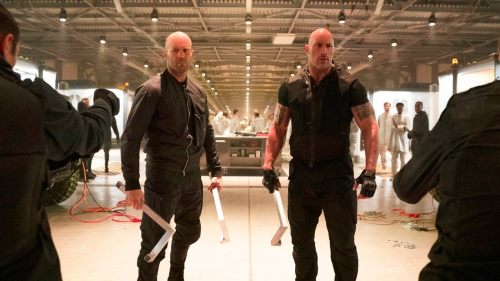TOKYO DRIFT: Finding Yourself As A Foreigner
The Fate of the Furious is almost here. Get your tickets now!
The Fast & Furious films are far flung from their origins. Once a story of petty criminals and street-racing, they now stand shoulder to shoulder with 007 in terms of globetrotting action. The genesis of this shift can be pinpointed to a specific entry: The Fast and the Furious: Tokyo Drift. While still very much about common thieves and car competitions, it also marks the arrival of writer Chris Morgan and director Justin Lin, the duo who radically altered the franchise focus by crafting a thoughtful piece that, admittedly, doesn’t gel with the rest of the series but still broadens its scope and its worldview. Not only did it take the Fast films outside America physically, it also brought them a more globalist perspective.
Tokyo Drift is a film about culture, both as a specific fish-out-of-water story and a nebulous look at the rigidity of national identity. Its very first scenes are of an American teen who looks and feels out of place, even in America, seeing but not entirely absorbing the images around him. His purple-clad home team The Ducks are everywhere, reveling in the imagery of a white sportsman gleefully beating a piñata in the shape of a Native American tribesman – likely the racist mascot of an opposing team – but this registers with Shawn Bosworth about as much as the twisted nature of a kid being bullied by having the Ducks’ signature purple spray-painted onto his body, as if to mark him with the status quo. Shawn doesn’t care about this culture, nor does he approve of it, but he doesn’t speak up until the same white sports star crosses his path, engaging him in a reckless racing challenge with his girlfriend as the prize.
This is the American side of his identity, and the identity of the Fast films up until this point, but where the typical action hero gains his “get the girl” victory, Shawn totals his vehicle in masculine pursuit of a girl-as-trophy not once, but twice. First in America, the incident that gets him sent to live with his father in Tokyo, and second as soon as he arrives, getting in way over his head in a drifting culture he doesn’t understand. It’s here that the film’s cultural conversation begins, pitting Shawn in an unfamiliar environment seen by many as exotic, but never contextualized as such by the film. In Tokyo Drift, Shawn is the exotic one. The sore thumb. The outsider. The “nail that sticks out,” as his Naval Lieutenant father warns him, telling him he’ll be the first to get hammered.
Shawn spends his time in Tokyo with Twinkie (Bow Wow), an African American army brat, Neela (Nathalie Kelley), a Japanese national of mixed ethnicity, and Han (Sung Kang), a Korean-American escaping his past, none of which are ideal things to be in ethno-centric Japan, especially when the primary antagonist is Neela’s Yakuza-adjacent boyfriend. While Shawn is certainly likely to have it easier than the rest – white exoticism comes with its benefits in many parts of Asia – he too is labeled a gaijin, or an “outsider,” and the combination of limited cultural experience and eagerness for trouble don’t exactly do him any favours. He picks fights with the wrong people, and his psychoanalysis of Neela as a fellow pissed-off army kid is way off the mark, revealing a penchant filtering of everyone else’s stories through his own narrow worldview.
Shawn doesn’t understand the culture he’s in, and in true Fast fashion, this idea is expressed through cars and how they’re driven. From the get-go, Shawn drives to win. It’s what gets him in trouble and it’s what keeps him there, the notion of outwardly masculine physical pursuit as western heroism, but it isn’t until his conversation with Han that he begins operating on a different wavelength. To Shawn, a white teen hailing from the open roads of America (the car culture that led to the Fast films in the first place), beating someone in a race makes you the better man. To Han, a man who’s seen more, lived more and experienced more, it just makes you faster. That’s all.
Han drifts primarily to impress the ladies, but it’s with Neela that Shawn experiences a new path to vehicular bliss. A dense city like Tokyo is the logical place for drifting to take precedence over drag-racing, but high on the winding mountain side, with no danger of running into bystanders or pedestrians, Neela and her crew drift peacefully by moonlight. It’s a scene that feels less competitive and more dance-like or meditative, even ritualistic, as if they’re completely in tune with their cars. For once, drifting isn’t something you do – it’s something you feel.
Granted, the film’s climax does sort of work against everything it’s built on (it ends with that same idea of physical competitiveness being the ultimate victory), but the majority of it remains one of Hollywood’s most interesting treatises on cultural assimilation. When Neela tells Shawn that “Outsider can mean many different things,” it’s a pivotal moment of mutual understanding, wherein Shawn learns that no matter how much he tries to fit in, he’ll always be on the peripheries, but it’s from this point on that he changes his approach, seeking not to apply the logic and values of the racing he’s familiar with (that pesky best/fastest dichotomy drilled into his brain, a manifestation of Western material success), but rather learning and accepting the more spiritual aspects that others may find in it.
Reductive as the metaphor might be on the surface, it rings true as a reconciliation of Eastern and Western cultures regardless, a dilemma that Taiwanese-American Justin Lin is no doubt familiar with. His debut film Better Luck Tomorrow is all about one side of that experience, the Asian Americans who drift through life after having surpassed their academic potential. The adoption of a “gangsta” mentality is often what follows, a specifically Western form of assimilation for many first and second generation Asian Americans, but the flip-side to that experience is trying to find yourself through Eastern culture as a Westerner, which is what Tokyo Drift is so adept at expressing, albeit through a white character with no prior connection to Japan.
Interestingly enough, Better Luck Tomorrow is also Han’s first film appearance, so it’s fitting for him to end up in East Asia for the second part of the conversation. He’s no stranger to feeling split between cultures, and his advice ultimately helps Shawn find his own sense of purpose as a constant outsider:
“Fifty percent of something is better than a hundred percent of nothing.”



